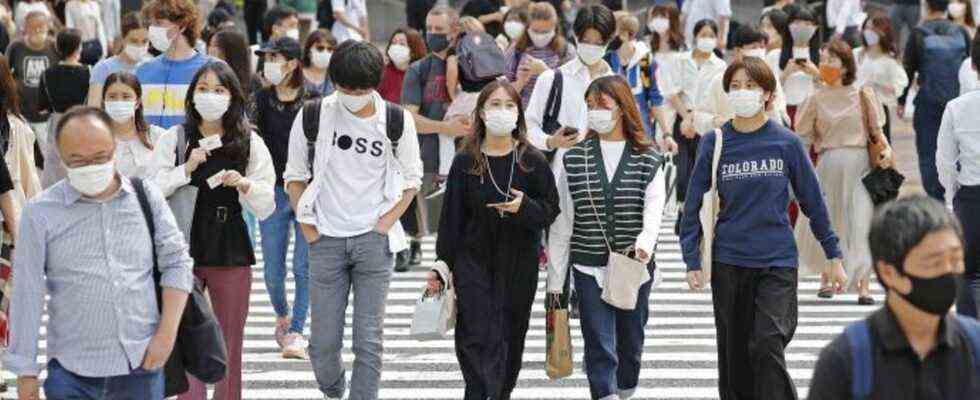High vaccination rate
From vaccinator to pioneer: How Japan overcame skepticism in its own population
For many people in Japan, wearing a mask was part of everyday life even before the pandemic
© Kyodo / DPA
During the Olympic Games, Japan was still considered a hotspot: the number of infections was high and the vaccination rate was low. But now the country has the pandemic well under control – despite a vaccine-skeptical population.
The tide has turned in Japan. In the summer, the country was still struggling with high infection numbers over 30,000. The vaccination campaign, which started late, was unable to stop the rapid spread of the virus, and the health system was considered to have collapsed for months. And then there was the Olympics. The games in Tokyo were a thorn in the side of many Japanese people. Not only because they feared that the huge event would drive the corona numbers up even further, but also because they were fed up with the lockdown that was imposed.
But while other countries, such as Germany, are already struggling with the next wave, the situation in Japan is now downright relaxed. Public life is in full swing and almost all measures have been withdrawn. In mid-November, the state reported with 126 million inhabitants less than 80 new infections during the day. How did Japan do it?
Careful vaccination race to catch up: With structure and incentives
The answer is: with a record-breaking race to catch up when vaccinating. When the USA and Europe approved the first vaccines and started their campaigns at the end of 2020, Japan first stepped on the brakes. Given the widespread vaccine skepticism in the country, the government decided to re-examine the vaccines themselves before approving approval. The vaccination campaign only got underway in February, and by early summer not even a third of the population had been vaccinated.
What was criticized internationally as a vaccination failure turned out to be a smart move in Japan. The government’s cautious action increased confidence in the vaccination among many Japanese people. A large-scale advertising campaign with calls for vaccinations from prominent personalities from television, music and sports also contributed, as did the well-structured campaign itself. With the help of the military, provisional vaccination centers were set up across the country, so that there were hardly any waiting times. On good days, more than a million people are vaccinated here every day. Many large Japanese companies also offer their employees the injection.
In addition, the government relies on the tried and tested carrot method: In the old imperial city of Kyoto For example, those willing to vaccinate receive free entry to a popular Manga museum: After the vaccination at the entrance, they can stay there until the evening. Restaurants, shops and cultural institutions also attract vaccinated people with a variety of vouchers, discounts and raffles.
Where Omikron has appeared everywhere
12 images
Social pressure on the unvaccinated works
In contrast to Germany, the corona vaccination in Japan has never been the subject of heated political debates. Instead, the vaccination campaign was positively influenced by internal and external factors: on the one hand by the political culture, which attaches great importance to consensus, on the other hand by the high social pressure in society to follow the recommendations of the government. The chilling news about high death rates in other countries also motivated the many elderly people in particular to get vaccinations.
In addition, measures such as wearing masks and distance rules – which caused a lot of discussion in other countries – were part of everyday life in Japan even before the pandemic began: Compulsory masks did not even have to be introduced because mouth and nose protection is widespread, especially in winter. Social distancing is also not alien to Japanese culture – also out of respect for others. In the end, many opted for the vaccination out of fear of exclusion and wanted to show by demonstrating that it should not be avoided.
Within six months, Japan has catapulted itself from one of the lower places to the top position in the circle of the G7. Around 77 percent of the population are now fully vaccinated – the first-time vaccination rate is almost 80 percent. The country has even overtaken Canada (76.2 percent), while Germany (68 percent) is still lagging behind in the lower ranks.
“The sixth wave is a question of when as of whether”
Japan plans to start booster vaccinations in December. If the pace is maintained, the population should soon be boosted. Nevertheless, with the cold season of the year, health experts warn of a similar increase as last year. Japan also has to reckon with increasing infections again in winter, said the national chief epidemiologist Kenji Shibuya in an interview with the “Wirtschaftswoche“.
The first documented case of the omicron variant in the country is also of concern. A visitor who arrived from Namibia at Narita Airport near Tokyo on Sunday tested positive for the new corona mutation. Japan responded promptly with a renewed entry ban for foreigners. According to Prime Minister Fumio Kishida, the measure should apply for at least one month. In addition, the government plans to expand the capacity for intensive care beds by around 30 percent, increase the number of nurses and collect more data in order to be able to predict more quickly when hospitals will come under pressure.
“A sixth wave is more a question of when than whether,” says Yuki Furuse, professor at Kyoto University, who developed such a prediction tool. “With the current situation in Japan calm, it seems okay to lift some restrictions now. However, I am concerned that people will be able to revert to a ‘voluntary self-restraint’ state if they need to,” added he added.
One thing is certain, there is hardly a country that is currently better equipped against a sixth wave than Japan.
Sources: “daily News“,”FAZ“, RND, with Reuters and DPA material

